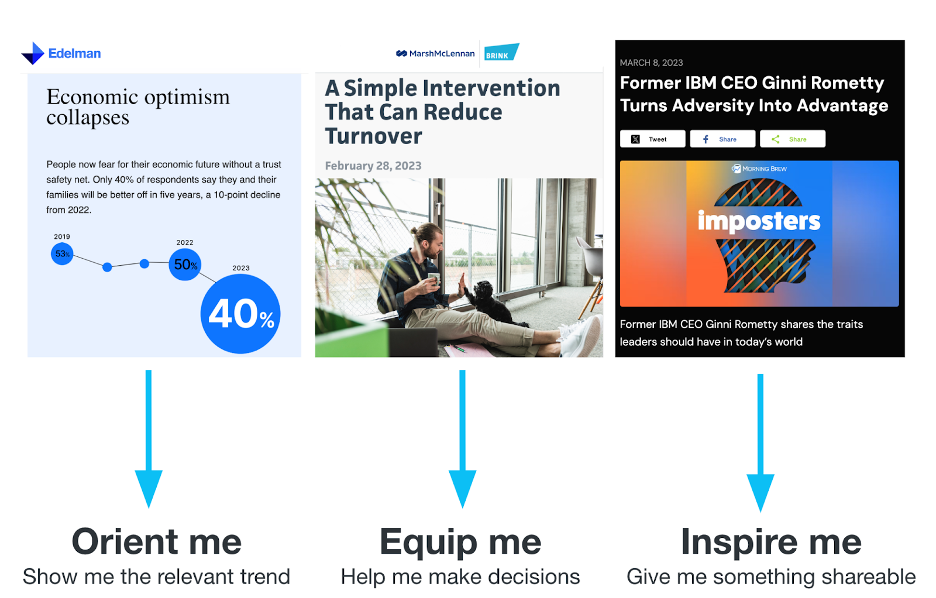Why every brand should build its own storytelling operation
It’s never been more important for brands to claim their own narrative. A brand newsroom gives you the tools and capability to shape compelling stories that not only reach but resonate with your audience.
Margaret Myers is a director on the editorial team at Long Dash. She is a former journalist who managed online coverage at PBS NewsHour and ESPN and led the features department at the Amarillo Globe-News. Karen Houston is a senior editor for Long Dash's newsroom projects. She manages publication operations for leading global professional services firms.
This is Part I of a three-part series on building a brand newsroom. Here, we show brand leaders how to define a brand newsroom’s purpose and engage its audience. In Part II, we dive into operations, staffing, and metrics. And in our forthcoming Part III, we will address how brands should think about the timeliness and relevance of their content.
Brands are on a daily mission to register in the consciousness of the audiences that matter to them. In the digital realm, they’ve tried everything from pop-ups and targeted ads that follow you around the internet to extensive social media campaigns and SEO-driven content strategies.
But the game of gaining people’s attention is rapidly evolving with the demise of third-party cookies and AI revolutionizing how we discover content online. And, unsurprisingly, most people actively avoid the traditional ways brands try to reach consumers, according to a Nielsen survey. With a few exceptions (like Super Bowl TV ads), we don’t want brands to talk at us. We don’t want to be sold to. For our precious attention, we require something in return.
The key here is then, how can a brand provide that value? How can it consistently and meaningfully connect with its audiences, earn their trust, and in turn expand its reach? How can it cut through the noise rather than adding to it?
The most engaged and category-defining brands unlock this value exchange through storytelling.
When we work with brands to bring their stories to life, we draw upon our roots in newsrooms—where editors and reporters actively listen to their communities in order to serve them with stories that reflect their needs. Just like these journalists collaborate to provide audiences with insightful, engaging content that informs and provokes thought, brands similarly can develop a strategic hub that centralizes its communications to ensure each narrative provides real value and resonates with its target audience. We call this a “brand newsroom.”
Why a ‘newsroom’?
A brand newsroom is a brand’s own editorial operation that emulates the standard of a modern media newsroom. It is equipped with qualified editors and writers—often former journalists—who produce stories that align with their brand’s strengths or area of expertise, while offering audiences genuine insights or even solutions.
When content adds something useful, entertaining, or educational to a person’s day, brands are cultivating a lasting affinity with their audiences, not chasing the fleeting contact of traditional advertising. It’s not about selling but about engaging with the audience on a deeper level, providing them with content that adds value to their lives and enhances their connection to the brand.
That same Nielsen survey also showed that if a brand creates content that has value beyond solely aiming to sell something, most consumers say they’re likely to buy the product. This is not to illustrate the transactional potential of brand storytelling, but rather the potential for deepening trust, sparking curiosity, and supporting mutually beneficial interactions between brands and their audiences.
Cultivating this relationship is based on drawing audiences in, rather than pushing the brand onto whoever will listen. This is what differentiates a brand newsroom from some of the more traditional methods of brand communications, like advertising or even press releases.
Brands newsrooms give organizations the opportunity to:
- inform and educate, not promote or sell
- create enduring engagement, not short-term transactions
- capture interest, not pageviews
- connect brands to ideas, not products or services
- be sought out, not avoided
Starting a brand newsroom may feel like an overwhelming project with a lot of unknowns. In this three-part series, we will show you how to get started. Here, we kick off by showing you how to identify the purpose of your content and then how to consistently engage and resonate with your target audience.
Just as a news organization like The New York Times has a clear mission “to seek the truth and help people understand the world,” your brand newsroom should have a well-defined purpose that guides what stories you tell and how you tell them.
In Part II, we dig into some of the operations of a brand newsroom, including a staffing model that leverages your brand’s top experts, workflow recommendations, and more useful examples for measuring success that go beyond just pageviews.
And in Part III, we will address questions related to timeliness and relevance. In this era of heightened attention to social and political issues, it’s vital that brands navigate carefully, ensuring their content is always useful and resonant with their audiences.
Start by defining the purpose of your brand newsroom
Just as a news organization like The New York Times has a clear mission “to seek the truth and help people understand the world,” your brand newsroom should have a well-defined purpose that guides what stories you tell and how you tell them.
Your brand’s editorial mission—we sometimes call this an editorial positioning statement—is not the same as your organization’s mission statement. Rather it distills how your brand’s objectives translate into engaging, valuable content that speaks directly to your audience’s interests and needs. Your editorial positioning statement acts as a compass for content creation, ensuring that every story not only reflects your brand’s identity but also serves its strategic objectives.
This statement should guide answers to questions like: “What content do we pursue that’s unique to our brand?” “What actions should our stories inspire in audiences?” and “What are we ultimately trying to achieve with this content?”
For example, we helped a nonprofit newsroom develop a positioning statement that helped them clarify their distinct role in achieving the overall mission of the organization. The statement read in part:
Through narrative storytelling and advocacy journalism—developed in partnership with communities and experts—our content empowers citizens to act as agents of change in the fight for racial justice.
A positioning statement like this one is internal-facing. It’s meant to guide your newsroom team as they pitch and plan stories that will populate your brand’s editorial calendar.
You should create an editorial positioning statement in partnership with brand stakeholders, including members of the communications and marketing teams and the editors and producers of the brand newsroom.
Think audience-first, not organization-first
Keeping in line with the newsroom comparison, brands should use a journalistic approach to creating content that genuinely engages audiences. Just as great journalism seeks the truth and prioritizes the interests of the audience, brands must craft their narratives with a similar dedication to authenticity and relevance.
Brands can adopt a journalistic approach by relentlessly focusing on audience needs over organizational priorities. This requires a mindset shift, from organization-first to audience-first: Instead of simply talking about your brand, give people something to talk about, think about, or do.
When it comes to creating audience-first stories that engage, we use a “jobs-to-be-done” method. Put simply, every story you produce must do a specific “job” for someone. Audiences don’t necessarily want an article, or a video, or a podcast—they want to become more aware, enlightened, or activated. The content your brand creates should fulfill a certain emotional need in your audience’s lives.
Here’s what we mean: A brand story about sustainability shouldn’t just list a bunch of facts about company initiatives and goals. To be memorable, a story must do more than simply inform.
Audiences want to be amazed or surprised. So how can a story about sustainability challenge their assumptions? Audiences want to feel connected to their community and the world around them, so how can a story motivate them to make a change (or potentially a purchase)?
Patagonia Stories consistently gives its audience something to think about. Their audience is made up of outdoor lovers who care about the environment and are willing to spend more on sustainable products. With stories like Dude, Where’s My Hatch? and Why Do We Keep Buying New Stuff? the brand surprises these folks with new angles and arguments that appeal to their sense of curiosity and desire to understand the world they live in—and what’s at stake if they don’t act to protect it. These stories do the “job” of fostering a sense of community among informed advocates and conscious consumers.
In a series of articles we produced for Twitter (now X), we developed the editorial series Common Thread to educate users on how the company approached often misunderstood topics. We focused on two main jobs that these stories could do for users: to “demystify” by pulling back the curtain on X’s philosophy, thought process, and how its values inform its decisions; and to “orient” them by putting X’s decisions into the context of trendlines, not just headlines. We did this by talking to experts inside the company and including their voices and ways of thinking into the articles. Their point of view helped to humanize the brand, thus fostering a deeper connection and trust with the audience.
The jobs-to-be-done method is useful because it can be applied to any type of content and, more importantly, it helps tailor your message to your audience’s needs. Here’s an array of B2B content aimed to fulfill a job for a busy executive.

As you can see in these examples, no matter the format—a data story, a resource article, or a podcast—each piece of content performs a distinct job for the reader or listener. Identifying what you want your content to accomplish will guide how you craft your story. It will ensure that every piece of content not only captures their attention but also delivers real value.
These are just a few ways brands can start to envision and plan their brand newsroom. In Part II, we assembled three practical considerations to help brand leaders operationalize a working newsroom.





